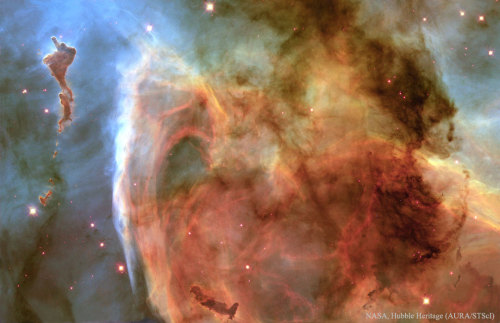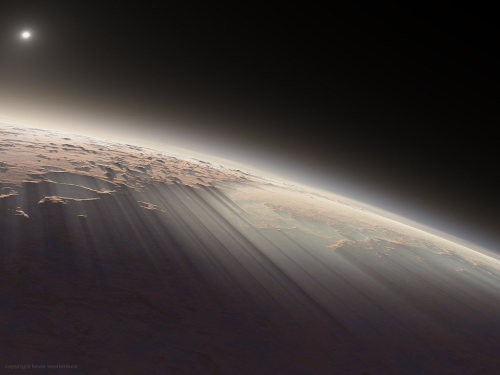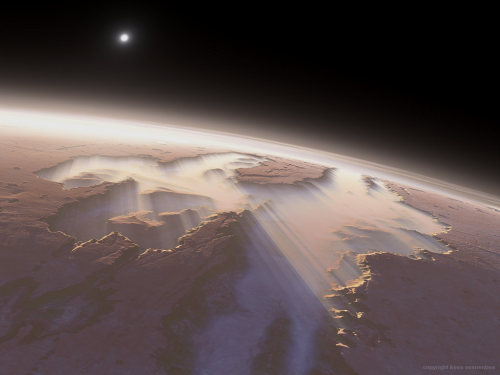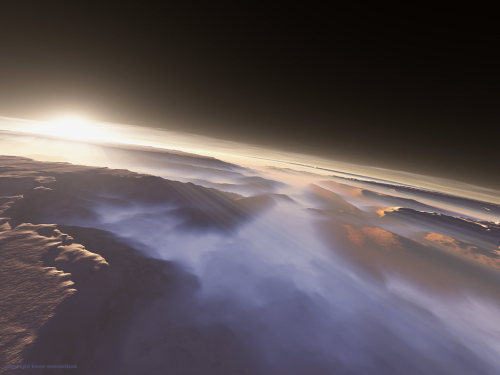Emission Nebula Sh2-72

Emission Nebula Sh2-72
js
More Posts from Littlecadet-biguniverse and Others
'Enterprise' Nebulae Seen by Spitzer
NASA - Spitzer Space Telescope patch. Sept. 8, 2016
Image above: These nebulae seen by NASA’s Spitzer Space Telescope, at left, may resemble two versions of the starship Enterprise from “Star Trek,” overlaid at right. Image Credits: NASA/JPL-Caltech. Just in time for the 50th anniversary of the TV series “Star Trek,” which first aired September 8th,1966, a new infrared image from NASA’s Spitzer Space Telescope may remind fans of the historic show. Since ancient times, people have imagined familiar objects when gazing at the heavens. There are many examples of this phenomenon, known as pareidolia, including the constellations and the well-known nebulae named Ant, Stingray and Hourglass. On the right of the image, with a little scrutiny, you may see hints of the saucer and hull of the original USS Enterprise, captained by James T. Kirk, as if it were emerging from a dark nebula. To the left, its “Next Generation” successor, Jean-Luc Picard’s Enterprise-D, flies off in the opposite direction. Astronomically speaking, the region pictured in the image falls within the disk of our Milky Way galaxy and displays two regions of star formation hidden behind a haze of dust when viewed in visible light. Spitzer’s ability to peer deeper into dust clouds has revealed a myriad of stellar birthplaces like these, which are officially known only by their catalog numbers, IRAS 19340+2016 and IRAS19343+2026. Trekkies, however, may prefer using the more familiar designations NCC-1701 and NCC-1701-D. Fifty years after its inception, Star Trek still inspires fans and astronomers alike to boldly explore where no one has gone before.
Spitzer Space Telescope. Image Credits: NASA/JPL-Caltech
This image was assembled using data from Spitzer’s biggest surveys of the Milky Way, called GLIMPSE and MIPSGAL. Light with a wavelength of 3.5 microns is shown in blue, 8.0 microns in green, and 24 microns in red. The green colors highlight organic molecules in the dust clouds, illuminated by starlight. Red colors are related to thermal radiation emitted from the very hottest areas of dust. JPL manages the Spitzer Space Telescope mission for NASA’s Science Mission Directorate, Washington. Science operations are conducted at the Spitzer Science Center at Caltech in Pasadena, California. Spacecraft operations are based at Lockheed Martin Space Systems Company, Littleton, Colorado. Data are archived at the Infrared Science Archive housed at the Infrared Processing and Analysis Center at Caltech. Caltech manages JPL for NASA. For more information about Spitzer, visit: http://spitzer.caltech.edu http://www.nasa.gov/spitzer Images (mentioned), Text, Credits: NASA/Tony Greicius/JPL/Elizabeth Landau/Written by Robert Hurt, NASA’s Spitzer Science Center. Greetings, Orbiter.ch Full article

New view of the Pillars of Creation
js

Expedition 48 Crew Preparing to Return Home via NASA http://ift.tt/2bV7T75

Saturn in three bands of infrared light.

Milky Way js

Gum 29 Star-Forming Region **follow viralography for more amazing photos**

Keyhole Nebula, inside the larger Carina Nebula






Morning On Mars
Martian sunrises, as seen by the HiRISE orbiter


M8 - Lagoon Nebula Up Close
June is “Lagoon Month” from my latitude. The June and July New Moons will be dedicated to photographing this photogenic nebula. I have booked a camping trip in early June, so I should be able to start capturing some more photons then! :) Here’s my version with limited exposure time from 2013.
-
 melisa-may-taylor72 reblogged this · 6 years ago
melisa-may-taylor72 reblogged this · 6 years ago -
 melisa-may-taylor72 liked this · 6 years ago
melisa-may-taylor72 liked this · 6 years ago -
 a-universe-of-almosts liked this · 6 years ago
a-universe-of-almosts liked this · 6 years ago -
 metalzoic liked this · 6 years ago
metalzoic liked this · 6 years ago -
 ceciltheghost-blog liked this · 6 years ago
ceciltheghost-blog liked this · 6 years ago -
 veenusyuri liked this · 6 years ago
veenusyuri liked this · 6 years ago -
 random-fandom-mexican-girl liked this · 6 years ago
random-fandom-mexican-girl liked this · 6 years ago -
 fiona-cummins liked this · 6 years ago
fiona-cummins liked this · 6 years ago -
 speedrunner-fuchs-wulf liked this · 6 years ago
speedrunner-fuchs-wulf liked this · 6 years ago -
 iamdefinitelynotanalien liked this · 6 years ago
iamdefinitelynotanalien liked this · 6 years ago -
 xprincesspainx reblogged this · 6 years ago
xprincesspainx reblogged this · 6 years ago -
 jessica-marie-baumgartner liked this · 6 years ago
jessica-marie-baumgartner liked this · 6 years ago -
 therandominternetperson liked this · 6 years ago
therandominternetperson liked this · 6 years ago -
 nerdycashheroshepherd liked this · 6 years ago
nerdycashheroshepherd liked this · 6 years ago -
 mohamedfouad2100 liked this · 6 years ago
mohamedfouad2100 liked this · 6 years ago -
 16fahri liked this · 6 years ago
16fahri liked this · 6 years ago -
 delusionalunicorn78 liked this · 6 years ago
delusionalunicorn78 liked this · 6 years ago -
 nikunikunik reblogged this · 7 years ago
nikunikunik reblogged this · 7 years ago -
 breathingafterdrowning reblogged this · 8 years ago
breathingafterdrowning reblogged this · 8 years ago -
 deldelirium reblogged this · 8 years ago
deldelirium reblogged this · 8 years ago -
 pulsarlesbain liked this · 8 years ago
pulsarlesbain liked this · 8 years ago -
 glitteringstardust reblogged this · 8 years ago
glitteringstardust reblogged this · 8 years ago -
 portalsintodreamscapes liked this · 8 years ago
portalsintodreamscapes liked this · 8 years ago -
 wheatbee reblogged this · 8 years ago
wheatbee reblogged this · 8 years ago -
 gobinwang liked this · 8 years ago
gobinwang liked this · 8 years ago -
 fadedpaperclip reblogged this · 8 years ago
fadedpaperclip reblogged this · 8 years ago -
 criminallynerdy liked this · 8 years ago
criminallynerdy liked this · 8 years ago -
 jnina-blog reblogged this · 8 years ago
jnina-blog reblogged this · 8 years ago -
 stargazer333 reblogged this · 8 years ago
stargazer333 reblogged this · 8 years ago -
 asterialsapphire reblogged this · 8 years ago
asterialsapphire reblogged this · 8 years ago -
 hydrias liked this · 8 years ago
hydrias liked this · 8 years ago -
 howlsmovingbuttcheeks reblogged this · 8 years ago
howlsmovingbuttcheeks reblogged this · 8 years ago -
 importantkryptonitemagazine liked this · 8 years ago
importantkryptonitemagazine liked this · 8 years ago -
 kitty---kitty reblogged this · 8 years ago
kitty---kitty reblogged this · 8 years ago -
 hanta96 liked this · 8 years ago
hanta96 liked this · 8 years ago -
 fine-art-photography-universe liked this · 8 years ago
fine-art-photography-universe liked this · 8 years ago
GREETINGS FROM EARTH! Welcome to my space blog! Let's explore the stars together!!!
144 posts
